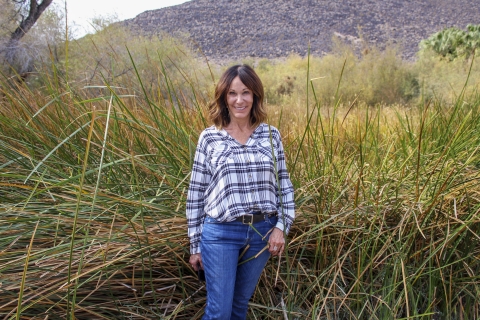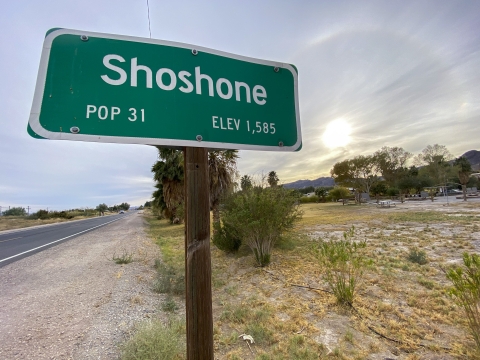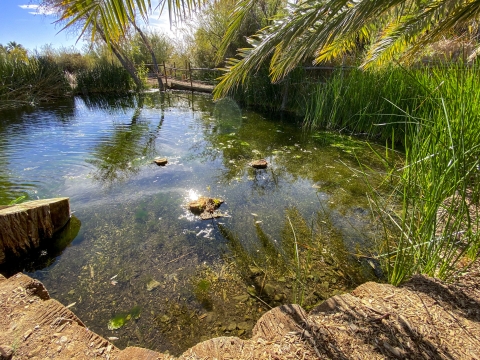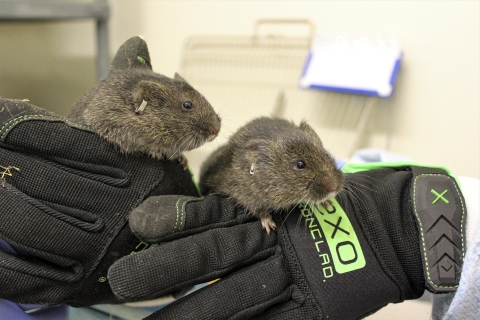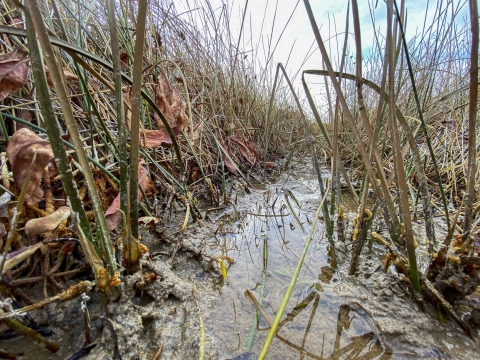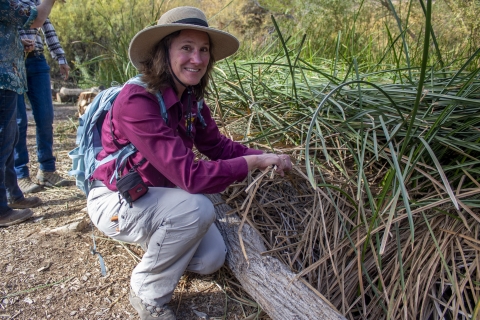“’Listen to the land’ is my mantra,” said Susan Sorrells, a 4th generation resident and owner of Shoshone, California.
Sorrells grew up in Shoshone, a small desert town located on the edge of Death Valley in Inyo County, and always had a close connection with the natural world.
“My family came here as pioneers in 1910,” she said. “Shoshone was one of the best places to grow up because it was surrounded by nature. I truly fell in love with the land and its people.”
Integrating nature with community became a part of Sorrells’ and her husband Robby Haines’ vision for stewarding the land. As a gateway to Death Valley National Park, ecotourism became their economic engine. These conservation-minded efforts boosted financially sustainability and helped recover endangered species, particularly a type of fish once believed to be lost.
In 1986, Fran Taylor, a Shoshone visitor and University of Nevada, Las Vegas, professor, spotted a small blue fish swimming in a cleared irrigation ditch that looked suspiciously like an extinct Shoshone pupfish. Taylor and Sorrells took photos of the specimen and mailed them to California Department of Fish and Wildlife. Phil Pister, senior biologist with the State, reviewed the photos and jubilantly confirmed to Sorrells that their sighting was indeed a Shoshone pupfish. Under his direction, biologists netted the not-so-extinct species and recovered 80 pupfish out of the ditch.
The discovery prompted Sorrells and CDFW biologists to create a pond for 40 of the fish. The other 40 pupfish were relocated to UNLV and University of California, Davis, in order to start refuge populations.
“The restoration was a tremendous success, and after about seven years, we increased our population of Shoshone pupfish from 40 to 800 fish, which we thought was outstanding,” said Sorrells. “Then it dawned on us that all of our pupfish genes were in one pond. In 2002, we got another grant and expanded their habitat to several ponds. From there, the population exploded from 800 to 8,000.
“I think it’s such a success story because they never became endangered,” said Sorrells. “They went from extinct to prolific so we are very pleased with the outcome. We’re committed to saving the land and aiding in species recovery — in turn, the beauty of the land is economically saving us with the success of our ecotourism business.”
Christiana Manville, a biologist with the U.S. Fish and Wildlife Service’s Partners for Fish and Wildlife Program, has been working with Sorrells for over 10 years, providing financial and technical assistance to implement habitat restoration and enhancement projects on her private land.
“Shoshone is very unique,” said Manville. “The greenness you see and the flowing water really stands out from the surrounding dry Mojave Desert, making the area a magnet for all types of wildlife. The work Susan has been doing is helping preserve biological diversity in the Amargosa River watershed; from the once lost pupfish species to spring snails, migratory birds and native Amargosa voles.”
Translocating Amargosa voles
This spring, Sorrells, with the help of the Service and Deana Clifford, from the State’s Wildlife Investigations Lab, plans to introduce a group of wild endangered Amargosa voles onto her property with the hope of establishing a new population. Over the past five years, she has been working with Manville and the Amargosa Vole Recovery Team to create suitable vole habitat. Members of the recovery team include the State, Bureau of Land Management, UC Davis, Amargosa Conservancy and U.S. Geological Survey.
First discovered and described in Shoshone in 1892, the Amargosa vole is a subspecies of California vole found nowhere else in the world, other than marshes along the Amargosa River in Tecopa, California. The State estimates that fewer than 500 individuals exist in the wild today.
“They’re actually in the field mouse family,” said Professor Janet Foley, who leads the Amargosa vole captive breeding program at UC Davis. “They resemble a dark brown hamster with white chin markings and have really pretty half-moon ears, as well as a short tail. This subspecies is unusual because they practice biparental care, meaning the father helps at least protect the young, which most voles do not do.”
Over the last 10,000 years, Amargosa voles became constrained to tiny isolated wetlands near Tecopa, many miles away from other voles, leading them to develop unique physiological adaptations. The subspecies evolved a little pocket in their stomach with specialized bacteria that helps them efficiently digest the available desert plants which otherwise have very low nutritional value. One major requirement for the species’ success is they need to be near water.
The newly created marsh where the voles will be released in Shoshone has all the necessary requirements for their survival, including water and dense, three-squared bulrush stands, which they use for both food and cover. Having a second vole population in Shoshone provides insurance for the species. If the population wipes out in Tecopa, the species will continue to exist in Shoshone; an essential recovery need according to the Amargosa Vole Recovery Team.
However, stewarding an endangered species is a huge responsibility, and a private landowner needs legal assurances under the Endangered Species Act in case something goes wrong.
“This couldn’t have been done without a safe harbor agreement, which is vital to those wanting to help endangered species recovery on private property,” said Sorrells.
Christiana Manville beside the newly created marsh where the voles will be released. Credit: Rebecca Fabbri/USFWS
Under the safe harbor agreement, the introduced endangered species can be removed any time the landowner no longer wants them there and the landowner is not held responsible for any incidental harm to the endangered species.
“What makes this safe harbor agreement unique is that she’s establishing habitat where there otherwise wouldn’t be,” explained Scott Hoffmann, Service biologist out of the Palm Springs Fish and Wildlife Office. “With this being part of the vole’s historical range, it’s a win-win and also exciting to be a part of.”
Sorrells is optimistic about the future with private landowners and conservation. “It’s not a pipedream, it’s real,” she said. “I believe if private landowners can embrace practicing and stewarding the natural environment and its creatures, it’ll go a long way with solving other environmental problems.”
“By working collaboratively, we’ll end up accomplishing more together,” said Manville.


